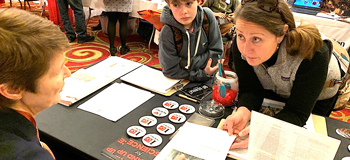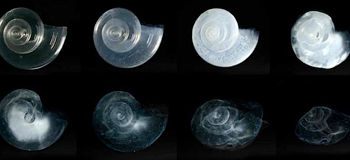The Question of Ocean Acidification
by Pamela Worth
Ocean surface waters
are now, on average,
nearly 30 percent
more acidic today
than they were in 1850.
Unprecedented floods that swamp cars and damage homes; dangerous storm surges that batter coastal roads and smash seawalls. We can already see the dramatic effects of climate change in the Northeast. But even on the clearest and calmest of days, a change is brewing in our world’s oceans that could have worse and more destructive consequences for local industries and livelihoods.
Oceans are warming and acidifying. Warming seawater has already caused economic damages such as periodic closures of Dungeness crab fishing. Ocean acidification is starting to take a toll. And the long-term effects of this change could be ruinous for marine life worldwide, and the people who depend on it for their food and income. Will ocean acidification hurt stocks in the Gulf of Maine, where the fishing industry nets hundreds of millions of dollars annually? If acidifying waters contribute to the decline of marine life in the region, can we slow the decline? Who is responsible for the damages—and can they be made to pay?

Acidity is a measure (in units of pH) of the concentration of hydrogen ions in a solution, in this case, ocean water.
What’s Happening Globally
While some emissions from burning fossil fuels are taken up by plants and animals on land, some linger in the atmosphere, contributing to the blanketing “greenhouse” effect that warms the earth. The world’s oceans absorb the rest, nudging its chemistry along the pH scale from basic toward acidic. Ocean surface waters are now, on average, nearly 30 percent more acidic today than they were in 1850. And ocean acidification is now happening at a faster rate than at any point in the last 66 million years. Projections show that if we do not reduce our carbon emissions, average ocean surface waters could be more than twice as acidic in 2100 as they were in 2000.
The consequences of acidification are disastrous to marine life. As carbon dioxide dissolves into the ocean, chemical reactions deprive shell-forming marine organisms such as crabs, corals, and foraminifera of the carbonate ions they need to build their protective shells. Studies done on commercially caught crab species in Alaska have found that crab survival rates drop consistently with more acidic waters. Coral reefs bleached by warming waters are less capable of rebuilding as their environment becomes more acidic. And populations of tiny foraminifera—an important food source for many species—risk a sharp decline, threatening the entire global food chain.
“Within the next decades, we’re fast approaching a threshold where particular organisms can’t form shells and deep-water corals can’t bounce back,” says Brenda Ekwurzel, director of climate science at environmental advocacy nonprofit the Union of Concerned Scientists.
What’s (Not Yet) Happening Locally
The Gulf of Maine is among the fastest-warming regions of the world’s oceans. For now, the drastic warming is associated with changes to ranges of key fisheries species in the region. Experts are monitoring of the potential effects of the accompanying increase in salinity and ocean acidification on shellfish and fisheries yields. According to Joe Salisbury, a research associate professor in earth sciences at the University of New Hampshire, it’s different on the West Coast.
“Oyster hatcheries in the US Northwest were the first to see the effects of ocean acidification on their stocks. They’ve had to take steps to reduce the damage,” Salisbury says. “But the effects of ocean acidification are being somewhat mitigated, or muted, in this region.”
However, he says, so long as emissions continue to increase, the changing pH of the world’s oceans will catch up with Gulf of Maine waters.
“Ocean acidification will prevail in the end,” says Salisbury, who also serves on the steering committee of the Northeast Coastal Acidification Network (NECAN), a group of scientists, resource managers, and marine industry partners who support research into the effects of acidification.
“It might be in 50 years, it might be in 100 years, but it’s not going to go away,” he says. “Fishing communities understand it’s a clear threat, and they want to know how it will affect their bottom line. We’re working on understanding how and when these impacts will be felt.”
Trying to Get Ahead of Acidification
A scientific formula
shows just how much responsibility for
hotter temperatures
and rising seas
can be attributed
to 90 companies.
At Mook Sea Farms in Walpole, ME, Head of Research and Development Meredith White is well aware of the impending danger of acidification on the oysters she helps cultivate in the Damariscotta River. While mature oysters are thriving in the warmer waters, she says, larval and juvenile oyster production at the hatchery has already been negatively affected by ocean acidification. As a result, larval and juvenile oysters are now raised in buffered waters in the farm’s hatchery, where they can grow their shells in ideal conditions. And White and company owner Bill Mook are participating in multiple studies with different regional institutions—including NECAN—to help track the effects of ocean acidification on their oysters.
“Understanding how all of this works, and how it will progress as ocean acidification continues, is a big priority for us,” says Mook. “This is why we are conducting our own field-based experiments and urging others to do the same.”
White agrees. “It’s important to have a better understanding of how specifically juvenile and market oysters are affected by ocean acidification. It will be helpful to have field-based scientific research to know how bad the problem will be.”
Accountability for Acidification

Dr. Brenda Ekwurzel (left) from the Union of Concerned Scientists talks to an attendee of the Maine Fishermen’s Forum in March 2019. Roger Stephenson photo.
Scientists say that the warming and acidification occurring in the Gulf of Maine are not the products of natural cycles or changes, but of fossil fuel emissions.
At the Union of Concerned Scientists, Brenda Ekwurzel and her team have been working for years to understand the link between specific effects of climate change and the largest industrial producers of carbon emissions, such as ExxonMobil and Chevron. The team published a paper in the peer-reviewed journal Climatic Change debuting a scientific formula that shows just how much responsibility for hotter temperatures and rising seas can be attributed to 90 private, majority state-owned, or national companies.
The formula showed that emissions traced to those producers from 1854 to 2010 were responsible for 42 to 50 percent of the rise in global average surface temperatures, and 26 to 32 percent of global sea level rise. In 2019, the team applied the same formula to attribute documented changes in ocean pH to specific companies, resulting in another paper currently under review by a scientific journal.
From large-scale fishing operations to individual subsistence fishers, ocean warming and acidification pose an existential threat to the millions of people worldwide who depend on healthy oceans for their survival. The science of attribution can help many of the people facing the most immediate impacts take steps toward economic restoration. This is especially true in acidification “hot spots,” such as the Coral Triangle in the western Pacific Ocean. In that region alone, where marine biodiversity supports more than 100 million people, $6 billion in annual fisheries exports and tourism are now at risk.
Ekwurzel and her team’s research includes some quantification of the risk to lives and livelihoods for each of these hot spots—such as the number of jobs that could be lost—along with specific changes to oceanwater pH. If acidification does threaten the livelihoods of Gulf of Maine fishermen, the research being done now on its effects could dovetail with the Union of Concerned Scientists’ analysis to attribute specific damages to certain companies.
“If people at risk use our work in conjunction with regional studies dedicated to acidification, we have confidence that they could tie a portion of the harmful changes occurring in their specific location back to the fossil fuel producers,” Ekwurzel says.
Damage Prevention

Pterapod shell dissolved in seawater adjusted to an ocean chemistry projected for the year 2100. NOAA photo.
Acidification is such a rapid process, Ekwurzel says, that her team can track shifts in acidity in direct proportion to atmospheric carbon dioxide, just a year after its emission. The solution to ocean acidification is also the solution to global warming and sea level rise: rapid, drastic, widespread cuts to carbon emissions. Ekwurzel stresses the potential for damage prevention.
“For ocean acidification especially,” she says, “cutting our emissions now will make a noticeable difference in protecting our oceans. The swift reduction in carbon we need would most directly slow down the pace of ocean acidification.”
At Mook Sea Farms, Meredith White is hopeful about smaller-scale ways to protect their stocks.
“[If acidification increases], jobs could be lost. However, this can also create an economic opportunity for innovation in the aquaculture industry to find solutions to this problem,” she says. She cites institutions in Maine, including the Island Institute and Bigelow Laboratory for Ocean Sciences, that are working to research the efficacy of protective measures like co-culturing seaweed near mussel farms, buffering seawater, or using ground-up oyster shells to lower acidity. She also points to opportunities to reduce the acidification of coastal waters, which has other causes besides fossil fuel emissions, such as fertilizer runoff.
At the University of New Hampshire, Joe Salisbury says that the state of Maine has implemented some steps recommended by a task force he served on—the Ocean Acidification Commission—to prevent and mitigate acidifying waters.
“I think we’ve done a lot better in monitoring and education, and in trying to understand the connection between land-based processes and coastal ocean acidification,” he says. “We still have a long ways to go.”
Of course, he adds, mitigation measures, education, and further study can only go so far in a world with unchecked emissions.
“The elephant in the room is the carbon dioxide,” he says. “Until we reduce carbon in the atmosphere, ocean acidification is going to keep increasing.”
Disclaimer: the author is employed by the Union of Concerned Scientists as a staff writer.
